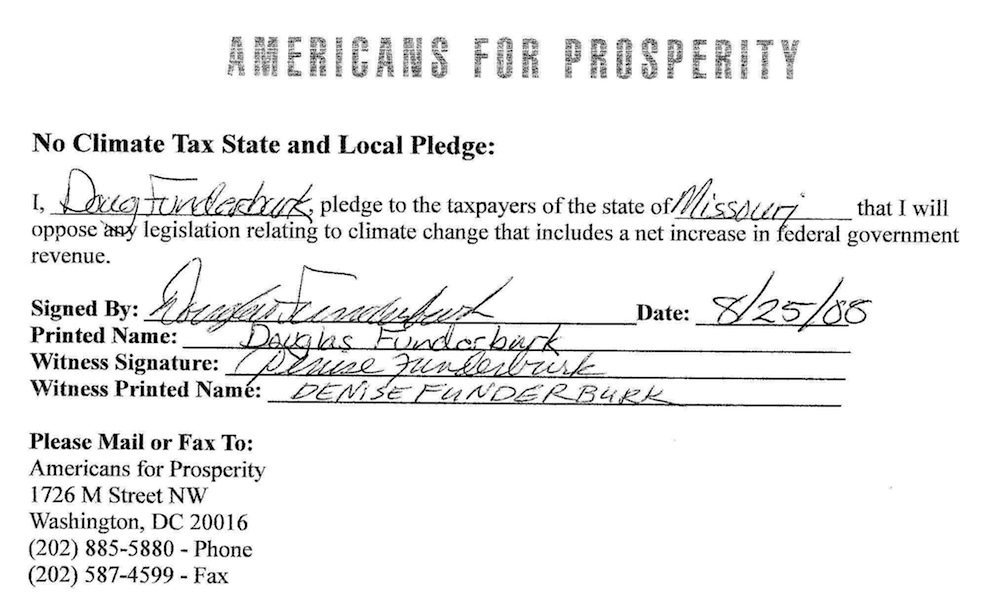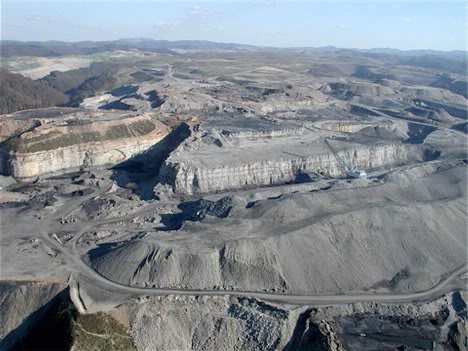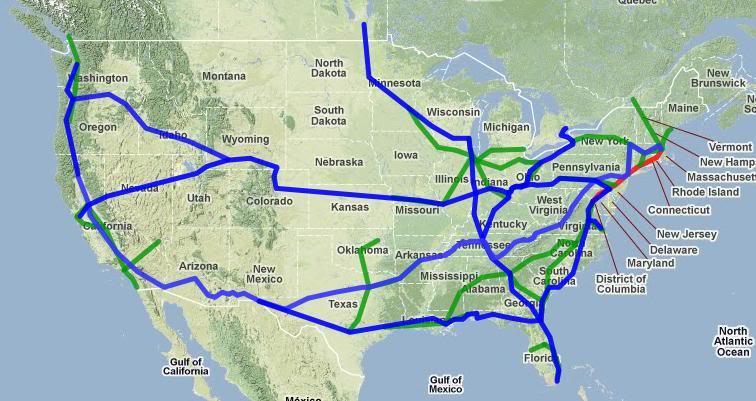 Grist this last week covered an often overlooked element of climate suicide policy of those famed climate kamikaze's the Koch Brothers:
Grist this last week covered an often overlooked element of climate suicide policy of those famed climate kamikaze's the Koch Brothers:
Since 2008, the Koch-backed group Americans for Prosperity has been urging candidates and politicians to sign its “No Climate Tax Pledge.” In 2010, we noted that many Republican House and Senate candidates had signed it, and in 2011, that at least one GOP presidential candidate had.
But it turns out the pledge has been far more widespread and influential than most people realized. From the Investigative Reporting Workshop:
A quarter of senators and more than one-third of representatives have signed a little-known pledge — backed by the Kochs — not to spend any money to fight climate change without an equivalent amount of tax cuts....
Grist directs our attention to the New Yorker, which has more information, also drawn from the original report, "The Koch Club:
When President Obama unveiled his program to tackle climate change last month, he deliberately sidestepped Congress as a hopeless bastion of obstruction, relying completely on changes that could be imposed by regulatory agencies. A two-year study by the Investigative Reporting Workshop at American University, released today, illustrates what might be one of the reasons why he had to take this circuitous route. Fossil fuel magnates Charles and David Koch have, through Americans for Prosperity, a conservative group they back, succeeded in persuading many members of Congress to sign a little-known pledge in which they have promised to vote against legislation relating to climate change unless it is accompanied by an equivalent amount of tax cuts. Since most solutions to the problem of greenhouse-gas emissions require costs to the polluters and the public, the pledge essentially commits those who sign to it to vote against nearly any meaningful bill regarding global warning, and acts as yet another roadblock to action.
...
Climate-change policy directly affects Koch Industries’s bottom line. Koch Industries, according to Environmental Protection Agency statistics cited in the study, is a major source of carbon-dioxide emissions, the kind of pollution that most scientists believe causes global warming. In 2011, according to the E.P.A.’s greenhouse-gas-reporting database, the company, which has oil refineries in three states, emitted over twenty-four million tons of carbon dioxide, as much as is typically emitted by five million cars.
But what is the specific pledge?

I {name} pledge to the taxpayers of the state of {state} that I will oppose any legislation relating to climate change that includes a net increase in in Federal Government revenue.
As a shorthand, we can called those who have signed the pledge "climate kamikazes", and the pledge the "Climate Suicide Pact".
Rather than look at the range of policies that this pledge is aimed at blocking, what I am looking at this Sunday is a range of policies that sidestep this pledge entirely, so that climate kamikazes that have signed the pledge can not hide behind the pledge in their opposition to these policies.
Renewable Energy Portfolio Requirements and Feed-In Tariffs
 Feed-in Tariffs are the number one priority in the establishment of a significant increase in renewable energy production.
Feed-in Tariffs are the number one priority in the establishment of a significant increase in renewable energy production.
Under the current regulatory regime, individual producers normally sell into the grid at a price set by an artificially constructed wholesale energy market. This means that the cost of bringing the most expensive required source of energy onto the grid determines the wholesale price of power.
This is a price regulation system that is designed in the interests of fuel-burning power generators. Consider a regional system that has coal-fired power plants, combined cycle natural gas power plants, and gas turbine peaker plants.
Among fuel-burning plants, coal tends to be the lowest cost per extra Kilowatt-Hour generated. The flip side is that coal power plants are more capital intensive, and so they need to be kept running on a fairly steady basis to cover their debt overheads. The bidding market ensures that they stay running most of the time, and get a bonus whenever it is required to bring more expensive Kilowatts onto the grid.
The intermediate natural gas combined cycle generators, which run a natural gas turbine and then generate power from a thermal plant using the exhaust, are cheaper per extra Kilowatt Hour than a pure turbine gas power plant, because they are more efficient and generate more power from the same amount of natural gas. But they are also more expensive to build per Kilowatt Hour capacity, so they get to run more frequently than pure natural gas turbine peak power plants.
Finally, during peak loads, natural gas peaker plants kick in. These are relatively capital efficient, but energy inefficient. Under the artificial wholesale power market, they are only turned on when the wholesale price goes high enough to justify the fuel that they burn. And they can recover their debt overheads even if they are only turned on 5% to 10% of the time.
As another part of the system, in a common rule established even before the artificial wholesale power markets were established, a power generate must typically promise to deliver a steady power supply to the grid, and if it is unable to do so, must pay a penalty for failing to do so.
Now consider how this system works for the harvesting of a power source like the wind, where we either use the power or lose it. By far the largest share of the cost is the cost of the original equipment and installation, with maintenance and operations typically taking less than 10% of total replacement cost per Kilowatt Hour. This means that when the wind power is available, the wind power underbids any other power source in the market ... at the same time, reducing the cost of power to the consumers. But as wind intensity fluctuates, even if it is an entirely predictable fluctuation based on weather reports, the wind power generator gets paid at a further discount below the market price, due to penalties for drops in supply.
So on average, there are lower power prices in the market when the most wind is being generated, and higher prices when there is less wind being generated. While the presence of the wind power reduces average cost to the final customer, a large enough share of wind power can easily shoot itself in the foot, driving the price of power when the wind is blowing down below the price required to repay the original equipment and installation cost.
That threat results in less wind power being installed than we would otherwise have, and therefore in prices to the final customer being higher than they would be if we encourage a larger share of wind power.
The alternative, and equally artificial, system is to pay wind power generators a fixed rate, which does not drop down when the wholesale price drops below replacement cost, and does not rise when the wholesale price rises to bring peak power plants onto the system. This is called a "Feed-In Tariff" (where tariff is a schedule of power prices rather than the more common meaning of a schedule of import tax rates).
Under Federal Law passed during Carter's time, a Utility Tariff has to be based on avoided costs. And on the face, this would seem to rule out a system of Feed-In Tariffs. However, in a regulatory ruling under the Obama administration, it was decided that penalties for failing to meet a Renewable Energy Portfolio Standard can be counted as part of avoided costs.
So now, establishing a Feed-In tariff for renewable power, either at a Federal or State level, can be a two step process of first passing a Renewable Energy Portfolio Standard, and then passing a Feed-In Tariff with the amount of Kilowatt-Hours that producers can sell under the Feed-In Tariff synchronized with the amount of Renewable Energy required by the Portfolio Standard.
Note that while we would expect many "climate kamikaze pledgers" to oppose this policy, they cannot hide behind their Climate Suicide Pact when doing so.
Carbon Tax with Social Dividend
 There is a funny thing about carbon pricing. The first reaction of legislators when passing any form of Carbon Tax (whether the tax is set at a fixed rate or set based on a carbon permit auction clearing price) seems to be to spend the proceeds on something. It is often spending directed toward complementary climate change policies, though it could also be driven by other priorities.
There is a funny thing about carbon pricing. The first reaction of legislators when passing any form of Carbon Tax (whether the tax is set at a fixed rate or set based on a carbon permit auction clearing price) seems to be to spend the proceeds on something. It is often spending directed toward complementary climate change policies, though it could also be driven by other priorities.
However, the primary job of the Carbon Tax is done when the price is charged for selling carbon-emitting fuels and other carbon-emitting raw materials. The tax revenue as revenue is entirely redundant to the main goal of forcing market buyers and sellers to take third-party costs into account when making their decisions.
Hence the Social Dividend. Under the Social Dividend, the funds collected are simply given back. If they are given back in a way that counts as a tax cut, then a pure 100% Social Dividend would bring any form of Carbon Tax into compliance with the pledge.
The simplest and most progressive form of Social Dividend would give an equal payment to each resident citizen. In order to ensure that the program is revenue neutral, the Dividend funds could be accumulated over a three month period then the total amount divided up by the eligible recipients and a check sent out.
Now, politically, it may be that this can be painted as paying people to do nothing. If so, the next most progressive form, and actually easier to administer, is to pay out the dividend through payroll tax rebates. Formally, this involves the carbon tax funds paying into the FICA funds on behalf of the income earner, so that the rebate is simply a smaller withholding than is actually credited.
The most progressive form of FICA rebate is to allocate one share to each income earner and each of their dependents. Carbon Tax funds are accumulated over a three month period, and then paid out again in the following three month period by introducing a threshold on income subject to FICA withholding for the period, with the threshold multiplied by the number of dependents claimed.
Note that the system with a pure Social Dividend tends to amplify economic trends, with bigger social dividends during economic booms and smaller social dividends during recessions. So the ideal system would integrate leaning against the wind into place by paying half of the fund out over three months and half of the fund out over two years. Then when the economy is growing, funds will be accumulating with an anti-inflationary impact, and during a recession the fund would be drawn down, with an anti-recessionary impact.
A Carbon Price of any form would be fought tooth and nail by the Climate Kamikazes. However, as before, they could not shelter behind their Climate Suicide Pact.
The National Defense Steel Interstate Tollways
 Third, as discussed a fortnight ago, we can convert 10% of our petroleum consumption to renewable power sources by establishing a system of national electric freight railways. This includes long distance 60mph heavy freight, 90mph rapid freight, and 110mph passenger rail, through a combination of overhead power supply and trackwork to create the network of Rapid Freight paths. The "final mile" transport can then be provided by some mix of freight on the conventional rail network and short and medium haul trucking.
Third, as discussed a fortnight ago, we can convert 10% of our petroleum consumption to renewable power sources by establishing a system of national electric freight railways. This includes long distance 60mph heavy freight, 90mph rapid freight, and 110mph passenger rail, through a combination of overhead power supply and trackwork to create the network of Rapid Freight paths. The "final mile" transport can then be provided by some mix of freight on the conventional rail network and short and medium haul trucking.
As noted, this program can be launched with two interest subsidy funding streams. The first is a $2b annual funding stream for interest subsidy of National Defense rail electrification bonds, with the bonds progressively retired by user charges. The second is a $2b annual funding stream for interest subsidy of National Defense Rapid Freight Infrastructure bonds, with the bonds progressively retired by track access charges.
Defense appropriations are limited to two years, which is far short of the time required insufficient to allow for the Tollway fee system to retire the debt. Therefore, while the Department of Defense STRACNET would be the project manager, the funding would located in the Department of Transportation, with a general fund appropriation. The spending offset would be part of the reduction in the regular Defense budget associated with the withdrawal from Our Longest War in Afghanistan, and since the PAYGO offset for the funding would be $1:$1 spending reductions elsewhere, there would be no net revenue increase associated with the program.
Therefore the National Defense Steel Interstate Tollways would be entirely compatible with the Climate Suicide Pact by the Climate Kamikazes of the House and Senate, so that, as with the two previous, the Climate Kamikazes could not hide behind the Climate Suicide Pact as they fight for Climate Suicide and against the Steel Interstates.
Indeed, with Generals testifying in front of Congress that this is a vital part of both National Security and Homeland Defense, and with actual war-gaming presently being done in the Pentagon already indicating that transcontinental freight transport is going to be a problem in the event of a serious petroleum supply disruption, the Climate Kamikazes could well find this to be the hardest policy to stand their ground in favor of Climate Suicide.
A Revenue Neutral Connie Mae
 The "Connie Mae" idea focuses on the fact that many of the benefits of more energy efficient or renewable energy productive systems are earned over time, while much of the additional cost is faced up front. This means that the finance cost for these energy-saving or energy-producing systems discourages investments that would be a net positive on easier finance terms.
The "Connie Mae" idea focuses on the fact that many of the benefits of more energy efficient or renewable energy productive systems are earned over time, while much of the additional cost is faced up front. This means that the finance cost for these energy-saving or energy-producing systems discourages investments that would be a net positive on easier finance terms.
This is even more the case for rental housing, where the landlord faces the problem that the rental cost of the housing is the headline price, while the cost to occupy is far more difficult to judge. Connie Mae financing can help encourage investments in rental housing energy efficiency that many resident homeowners would have long since been made.
The most direct way to establish a Connie Mae financing system is directly opposed by the Climate Suicide Pact. Under this approach, some revenue source is identified, such as a 1% import tariff on imported petroleum, and that revenue is used to subsidize the interest costs of the Connie Mae finance. That directly subsidized interest is spending, so under PAYGO rules must be offset by either an offsetting spending cut or by additional revenue. The offsetting spending cut faces a fight from whomever is getting their spending cut, while the additional net revenue is precisely what the Suicide Pact promises to vote against.
However, there is another approach. Connie Mae financing repayments for permanent improvements to a house may be tied directly to the utility bill, with the interest subsidy limited to an interest guarantee in the case that a house or apartment has its power turned off due to a transfer of ownership or change of tenants. That is a much smaller interest subsidy, and so much easier to find spending offsets for.
Because the interest on the Connie Mae program debt are federally guaranteed, the interest rate on the Connie Mae borrowing is substantially lower than regular consumer credit. The main Connie Mae interest subsidy is a 50% refundable tax credit on Connie Mae interest payments. The power company that is administering the Connie Mae payments sends out the Connie Mae Refundable Tax Credit form annually, which can be included with any tax return ~ including the 1040EZ.
Given that this is a real investment in the real productivity of the national housing stock, there is no sound public finance argument against funding this Connie Mae interest tax credit with deficit spending. However, given the Deficit Hysteria that plagues the DC area, a Spending or Tax Offset would be required under PAYGO rules. My favorite Tax Offset would be to fund the Connie Mae interest tax credit through reductions in Oil Company tax subsidies.
As with the three previous policies, the Climate Kamikazes could not hide behind the Climate Suicide Pact as they oppose this policy. However, a part of the political appeal of the Connie Mae tax credit system is that it is a political wedge policy. The standing Climate Suicide road and outer suburban development subsidies allies the Oil Lobby with residential construction and property development interests. However, few interest groups are as sensitive to the benefits of easy finance terms as the residential construction and property development interests. The Connie Mae finance opens up opportunities in a wide range of home redevelopment projects. It also opens up opportunities to acquire properties for resale after energy efficiency upgrades. So the Connie Mae finance directly benefits these long standing allies of the Oil Lobby.
Considerations and Contemplations
As always, rather looking for some overarching conclusion, I now open the floor to the comments of those reading.
If you have an issue on some other area of sustainable transport or sustainable energy production, please feel free to start a new main comment. To avoid confusion among those who might be tempted to yell "off topic!", feel free to use the shorthand "NT:" in the subject line when introducing this kind of new topic.
Next week, I expect to return to the Steel Interstate System, unless something comes up over the coming week that demands more immediate attention.
Comments
You take all the trouble that you can afford ...
... at least you won't have time to be bored.
A remark on context
But first, thanks for the usual comprehensive, fact-heavy analysis. I especially appreciate being educated on the feed-in tariffs idea.
So, this essay is the thinking of one private citizen, clear and creative, about how to approach a problem which threatens our species as a whole. What is the context for this analysis? First, the entire analysis is organized around how to avoid insane behavior from people with a lot of power. This is something I've been noticing a lot recently--how much citizen energy is wasted dodging monky wrenches hurled by psychopaths. Second, this is posted on a tiny blog and read by a handful of people. Why? Because a grounded discussion of this nature would never take place in the realm where decisions are actually being made. I notice in one of the extended quotes above, for example, that even in the rare instances that people make free to assume what science knows--that climate change is real--current insanity requires the qualifier "most scientists think" rather than something along the mor accurate lines of "a freight train hurtling toward destruction" which is obvious to anyone paying attention. This is a direct result of too much concentration of wealth, leading to too much concentration of power, which inevitably leads to too much concentration of political power. These two men can put their own profit making above the welfare of the human race and successfully cancel out the bets thinking of millions of well-meaning citizens who value the future of the species. They can dismiss valuing our race as a whole as "socialism" and get away with it..
Conclusion: the future does not look rosy for us or even for the Koch Brothers. Can there be such a thing as unintentional suicide? It seems that this is what we are looking at.
Ah, but its posted on four blogs, ...
.... read by four small handfuls of persons!
Achieving urgent social change always involves avoiding insane behavior from people with a lot of power. Those who have power got it from the leverage of the current social system, and when a change is urgent, its because vested interests had too much at stake in the problem to let it be solved before it became urgent.
And yes, the author of the New Yorker article wimped out with "most scientists think".
As far as how the future looks ~ I'm not prognosticating the odds, I'm advocating for change. Its going to be a rocky century ahead one way or the other, but the more of us work on what can be done, the better the odds of getting some useful change in place when an opening appears.
My whining was not intended to be comprehensive
At the very least, what else are you gonna do. I'm not sure any purpose is served by pointing out how bleak it is oher than my getting to express myself, but I like to think realistic appraisal improves the odds of success. In any case, the analysis is appreciated for the reasons you state and more.
Yes, the point is indeed, what you gonna do.
The fact is that the minimum we need to achieve is beyond the maximum that is politically feasible.
We therefore must change the rules of the political game in order to survive the century as an "American" society and an industrial economy. We either succeed in changing the rules of the game, or we go down in flames.
Given that, the only question I'll ask about whether to continue with relatively low impact blogging is whether its counter-productive.
Agreed
The counter-productive question is a good one. It is possibe that blogging somehow displaces real world activism, but that is not my opinion. I have no doubt that blogging is one of the few tools left to us through which to create awareness based in reality rather than in corporate wet dreams. I believe the challenge of how to translate thought to action would be even more daunting without blogging.
It's hard for me to believe --
that these people don't know what they're doing.
Let me suggest an alternative explanation -- they are afraid to make global warming a real issue because a total revolt would ensue, were the people to know their collective ultimate fate. So the idea is to do away with the people, and just settle for a damaged global ecosystem. The Koches have money -- they figure they'll survive.
For the Kochs, its quite possible ...
... I expect that they get no more pushback against whatever views they have about any particular issue than they are interested in tolerating.
And when any effective policy is going to personally cost someone billions in what they imagine their wealth to be, its likely to be easier to rationalize climate denialism.
It seems likely that the Big Oil corporations know what they are doing, but trasnational publicly traded corporations are structurally designed to be psychopathic, so psychopathic behavior from Big Oil corporations is not surprising.